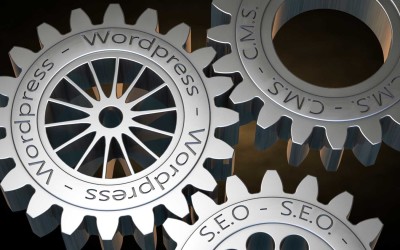Google makes it perfectly clear that when it comes to SEO they want more “user friendly” content and a better overall website user experience. So, over the past several years they have updated their algorithms to test for these things when ranking websites in their search engines.
They are looking for things like mobile-friendly sites and responsiveness, websites that aren’t keyword stuffing – a tactic that was used many years ago and is frowned upon now by search engines, duplicate content or “stock” copy, outdated code and design, thin content, and bloated images that cause pages to load slowly.
In a time when almost 50% of internet browsers are using their mobile devices, whether a tablet or smartphone, to access the web, these things are more important than ever and Google, Bing and other search engines do take them into account when ranking sites.
Many people redesign their older sites to bring them up-t0-date with technology and to make them look more modern, but often forget to do some “common sense” things to their new website in the process that could be hurting their ability to be found in search by clients and customers. This is costing them a lot of potential revenue, because they can’t be found readily online, since search engines are demoting them for these bad practices.
Double check to make sure that your website redesign, or even your current website, doesn’t suffer from these things.
1.) Not taking into account mobile users.
In 2015 mobile searches surpassed desktop searches. And, as of April of 2015, Google has started penalizing sites that aren’t responsive and mobile-friendly by demoting them in these searches. It’s important that your website have a mobile version in order to compete for top rankings.
And, whether your business is a local business, such as a bar or a restaurant, where people will be looking for them from cell phones while on the move, an ecommerce site, or any other type of site, doesn’t really matter.
Whether you want to believe it or not, people are using smaller devices to browse the web these day, and in greater numbers, so every website needs to have a mobile version of itself.
2.) Using stock, generic or manufacturer’s copy and content.
It’s not uncommon for websites in the same industry to share some of the same text and copy. Many companies specialize in servicing specific industries and offer “stock” content for websites to make it quicker and easier for their customers to get their website pre-populated with content.
The problem is that this causes what is known as “duplicate content” and it is hurting your site tremendously.
While it does take more work to rewrite manufacturer’s descriptions for products, if you run an ecommerce site, if you are not taking the time to do so you are competing against hundreds, if not thousands, of other web pages who already have the exact same content you are posting. There is nothing special on your website that will help you rise to the top in searches.
This doesn’t just apply to ecommerce sites either. You will actually find this situation on a lot of websites for lawyers, doctors, accountants, real estate agents, etc. as well. Many sites use the same boiler plate content from within their industry, without rewriting it to specifically target their own personal audience. Big mistake.
The goal should be to offer unique content that your viewers want to read and stay on your site for.
3.) Not thinking ahead about the structure of your site.
How visitors interact with your website is important. When planning your website structure, think carefully about the internal links within the site that will help guide visitors to the areas they may want to visit and keep them engaged.
This website structure, also known as funnel or flow, is important and should not be neglected. When people hear the term “funnel” they often think of “sales funnel,” but even if you aren’t selling an actual product, it’s still important to “guide” your visitors through your website in a logical way.
Sadly, it is an area that is often overlooked when planning a website. Many people just want to dive in and get their website started and posted online. You know the old saying about “failing to plan?” Yeah, it applies here for sure! Don’t let your website fail because you didn’t want to put the time and effort into actually planning it out beforehand.
4.) Not doing proper keyword research.
A lot of people think about keywords as something they will do “after the fact,” when their website is up and running. But, honestly, your content should help drive the design and knowing your keywords helps you to plan your content properly.
Make sure to think about what keywords you want to target before you start your website design. If your website designer (or you) doesn’t understand keyword research, or it isn’t built into your contract with them, consider hiring an SEO consultant to help you discover the keywords you should be targeting for your industry and locality.
Then make sure these keywords are properly written into your website copy for maximum exposure and best search engine results. If you are unable to write good copy consider hiring someone to take care of that for you.
The problem with waiting until “after the fact” to start optimizing for keywords is, nine times out of ten, despite people’s best intentions, it just never gets done.
Google makes it perfectly clear that when it comes to SEO they want more “user friendly” content and a better overall website user experience.
5.) Using coding and design practices and frameworks that are outdated.
Websites can be built in many different ways. Several years ago an entire website would have been built with inline code to style the pages. Now we use separate CSS files to hold the style information.
Sites that used to be built using straight HTML are now being built on Content Management Systems (CMS) like WordPress and Joomla.
It’s important to understand common programming languages that are updated regularly for things like functionality, security and speed. Not staying up-to-date on them puts your website at a disadvantage to your competitors that are.
Also, be sure to keep the software powering the backend of your website up-to-date, including themes, plugins and WordPress core files, if you are running a WordPress site. If you aren’t able to do this yourself, or simply don’t have time, perhaps you should consider hiring an expert in them on monthly retainer. The price can be relatively low to do so (less than $100 a month) and can be much less expensive than hiring a dedicated web employee to manage them for you. But, for the sake of the security of your site, make sure this important task is done.
6.) Stuffing your content with keywords.
Leave the keyword stuffing to the 1990’s. It’s no longer a good practice to follow and will get you penalized anyway. Google pays more attention now to the actual content of the page, which means your page could rank for several keywords, not just one that you are stuffing the heck out of it with.
And, if you are adding hundreds of pages to target a single keyword, with no real content value, you are just causing yourself to do lots of extra work for very little value. Don’t just add content for the sake of adding content. You can freely work your keywords into your content without overstuffing them so the pages sounds jumbled and incoherent.
Make your content more about value to your readers then about keywords, however.
7.) Not adding meta data to your site.
Be sure that each page on your site has a descriptive and unique title and meta description that matches the content of the page.
8.) Using large images that slow down your website.
Google wants fast websites. Period.
Images that haven’t been properly optimized for the web slow down your site and can cost you valuable “points” with Google. A large portion of images on the web are at a much higher resolution than they really need to be.
If you don’t have a graphics program like Photoshop available to you, run your images through an online site such as JPEGmini or Web Resizer to help you get them to the optimal size for online viewing.
Making sure your images are a proper size will help reduce your page load times, offering a better browsing experience for your users.
9.) Not creating a Google Webmaster Tools account and submitting your sitemap.
A sitemap is a file that search engines use to crawl your website and find your pages within it. It helps them understand what pages are there and how to index them. This can dramatically increase your chances of being found online.
It’s a basic SEO step, but one that many people don’t bother to implement because it scares them. Submitting a sitemap will increase your chances of being found quicker online, so it is highly suggested.
10.) Not doing proper 301 redirects when redesigning your website.
One thing I have noticed that a lot of web designers and developers, whether professional or amateur, never seems to remember to do when they are redesigning a website is to point the old URL’s to the new ones. If you have had a website online for years, chances are your pages have built up some search engine “juice” already.
When you redesign your website, you need to remember to either keep the exact same file structure (i.e. www.yourdomain.com/pagename pointing to www.yourdomain.com/pagename on your new site), or redirect the older pages URLS with a 301 to the new page URL that’s closest to the original content.
This way search engines will make sure that some of your built up “link juice” you accumulated over the years will pass on to the new page. If you don’t understand how to do 301 redirects for your website, hire someone who can help.
It would be a shame to switch over your entire site and lose all the search engine rankings you had built up from pages of your old site over the years and have to start all over again.
- Google Shakes Up Digital World: Free Website Service No More! - January 8, 2024
- Unleashing the Power of Storyboarding: A Practical Guide to Designing Outstanding Websites - September 20, 2023
- Why Your Business Needs a Professional Web Consultant: A Comprehensive Guide - September 5, 2023





